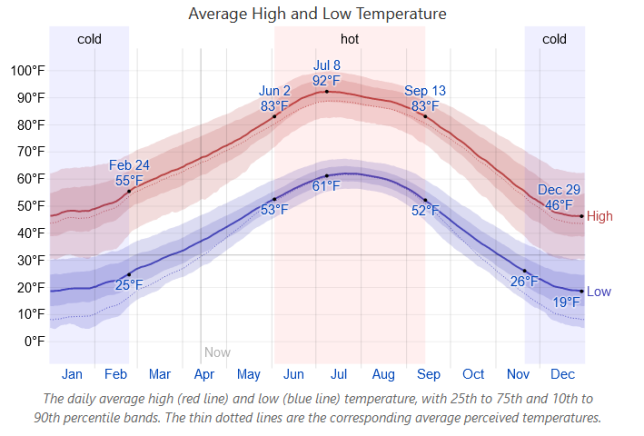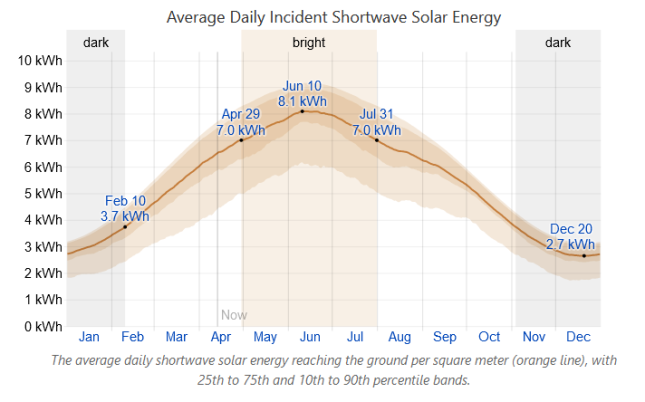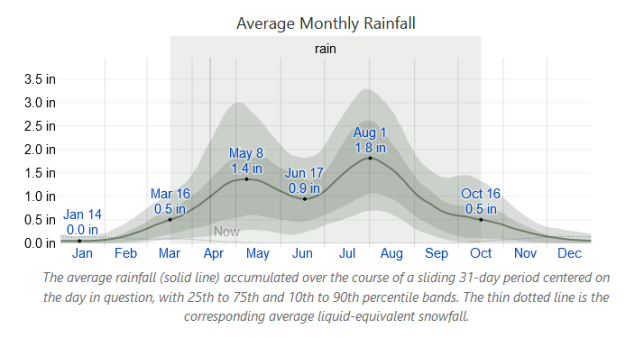For years now I’ve wanted to try and create some sort of ritual that would call the rain to me. After reading a paper by Jorgensen, which discusses the ways in which mythology symbolism can be layered into ritual/heka, I finally reached a point where I felt like I could finally wrap my mind around what such a ritual would entail. This post is basically about said ritual.
If you’re not interested in any of the peripheral discussion around it, and only want the rubric, jump to the bottom of the post to find it.
Ritual Concept
I knew that I wanted to incorporate some sort of myth/story structure into this ritual, but I had never found anything that really felt correct for me. As luck would have it, I was reading about different NTRW around the same time I was working on this and found that there is a particular NTR, Anhur, whose name essentially means “Bringer of the Distant One.” If there is something that has been distant where I live, it’s rain. My entire state is under a “exceptional” drought right now, which means that even our native species of plants are starting to succumb to the lack of water. At the time of creating this ritual, we hadn’t had rain of any quantity above 0.1″ since April 2020.
Yep.
And so when I saw that this particular deity brings back the distant one, I felt like this would be a great myth structure to use in creating a rain ritual. Further, Anhur has direct associations with the four winds, which I thought could be utilized to carry weather to wherever Anhur directs it. There is a tradition in my family that I felt would be useful for this endeavor: wind chime clappers. If you’re interested in seeing a bit more about it, I wrote about this once over here.
The Distant Goddess myth exists in many forms within Egyptian stories/literature, and so I could choose a whole host of different deities to invoke for it, but I aimed most of my attention at utilizing Menhyt as the goddess we are attracting. Her name has associations with green and greening, and I felt that she would be an ideal choice.
Ritual Experience
It just so happened that about the time I was thinking of creating this ritual, there was a storm front coming through. This was one of the only opportunities we’ve had for rain in months, and I didn’t want to miss my chance to be able to try this rubric out. When I first started working on this project, the chance of rain for 1″ was about 1%. By the time I performed the ritual, our chance had gone up to 10%.
In preparation for the ritual, I and my partner created clappers to hang on our wind chimes out of watercolor paper. I recommend a thicker paper for these, to allow them to have some amount of resilience against weather, but you could use whatever you have on hand. We chose to make five clappers because we have five chimes, but you could make as many or as few as you prefer (I think an ideal might be four – one for each wind direction.) There isn’t really a particular rule for creating these, I mostly just focus on attracting beneficial things to my area while painting them. I would say to let your gut/intuition guide you for this section, as I’m not particularly structured in how I create these.

I performed the ritual about a week before the weather was to officially arrive. I felt that it would make sense to do this a few days in advance to allow the weather to shift course, to build, etc. Compared to other rituals I’ve written, this one felt a little less clunky in my mouth. I feel like this ritual was written more in my way of speaking, and it felt less like I had taken chunks of various texts and cobbled them together into a rite. Perhaps it meant that was the direction I need to be going on for future rubrics?
After the ritual had been performed, I placed the chimes with their new clappers outside and waited to see what would happen. A few days later I had the urge to perform the rite a second time, and in this format I didn’t offer clappers, but shifted the verbiage to establish that the clappers (and therefore the wind’s voices) had been established by my hands (see more in ritual notes below). I didn’t originally intend on the ritual needing to be performed twice, but it felt right and so I went with it. After that, it was a lot of sitting on my hands waiting for the days to pass.
The rain here ended up being spread out across two-three days. The first day, we were gifted with a really bright and really close rainbow. I’ve yet to see anything this close to our house before.

In the evening we had very vivid clouds that traveled across the mountain range. They were often lit up by the setting sun into vibrant colors, and their forms reminded me of long snakes slinking over the mountains. It was interesting to be able to see how the wind would shift directions, carrying the clouds with it.
The next day we got a lot of rain. A large part of the state actually got a lot of snow. Throughout most of the afternoon, you couldn’t see very much for all of the clouds hanging across the mountain range. But when they finally broke for a short period in the evening, I could see that the entire rim of the Colorado plateau to the north of us was covered in snow. There were mountains that had more snow on them in that moment than I had seen in decades.

I remember thinking in that moment that I felt seen or heard. That it felt like someone had painted a beautiful picture for me. And while I know that there is no way to prove for a fact that doing this ritual caused any of this, its such a rarity for anything tied to religion to bring forth any such kinds of feelings within me that it was worth noting and writing down.
All in all, we had about .75″ of rain where I am at, which is a fair amount in a year like this. Up north, there were snowfalls ranging from 6″ to 20″, and there was a subsequent flash flood warning a few days later for the snow melt that would be rushing down to the valley floor. By the final day of rain, all of the clappers had been ripped off of their chimes, which signals to me that the heka has been used up, and I will need to create new ones to attract another storm.
Below are my notes on how to modify this rubric for your needs, along with the rubric itself. If you end up using this rubric, let me know how your experience goes!
Rubric Notes
This rubric calls forth and names the four directional winds in the opening section. The names of the north and south wind have been named based off of what function they serve where I live, as such, you may wish to change what they are called before performing this ritual. The east and west winds could stay as they are, as they are named after the path of the sun — which is unchanging for all of us. However, you may wish to take note of what the north and south winds do in your location and name them accordingly.
Also, this rubric is currently made to be done when first offering the wind clappers that you will hang on your wind chimes. If you would like to perform this ritual again after the clappers have been hanged (as I did), you would change the verbiage in that section from “I provide you with a voice” to “I have provided you with a voice.”
I’ve noted the sections that can be changed with a *
Approaching the Altar
See me great gods. See me and hear me on this day as I step out into the sunlight.
I call to you great gods. Hear me with both of your ears. Turn your beneficent gaze my way.
Do not repulse me upon your path. Do not impede me for I am Equipped, and my seat is firm.
I am the lord of the four winds, and I have dominion over that which I desire.
*I call out to the north-wind, the bringer of winter storms.
I call out to the east-wind, where Re’s path is born.
I call out to the west-wind, where mother embraces me every night.
*I call out to the south-wind, which brings summer water, growth and life.
Oh you winds that respond to me, Oh you bulls of the sky, go forth and establish the four pillars of the sky. Truly the four pillars are established, and the firmament is made secure.
I set forth upon the path made for me to bring close to me what was once distant, for I am he who brings the distant one back.
Offering Light
I bring forward the radiant light of Horus. It’s brightness on the horizon fills your eyes.
I bring forward the radiant light of Horus. It’s brightness on the horizon fills your heart.
The eye of Horus calls out to you, take its light to yourself and be filled with it.
The eye of Horus calls out to you, take this light to yourself and be made whole by it.
Come to that eye which makes you whole. Come to that which calls to you.
Come to that eye which makes you sound. Come to that which calls to you.
Offering Incense
I bring you the fire to alight your incense. I bring you the fire to fashion what you enjoy.
I bring you the fire to alight your sweetness. I bring you the fire to fashion what you enjoy.
Incense approaches, like the north wind, who sails toward the nose of her brother.
Incense approaches, its sweetness permeates your nostrils, it fills your chapel with its perfume.
Come to this sweetness which you enjoy. Come to this sweetness which envelops you.
Come to this sweetness which you enjoy. Come to this sweetness which I have created for you.
Offering Water
I bring to you the primordial waters to sate your thirst. I bring to you what flows from you.
I bring to you the primordial waters to make you pure. I bring to you what flows from you.
Feel the coolness of the libation filling your cup. Feel the coolness upon your throat.
Feel the sweetness upon your lips. Feel the pure water upon your skin.
Come to these waters and take them to your countenance. I have poured them just for you.
Come to these waters and quench your thirst. I have brought you what you desire.
Offering Food
I bring you nourishment to fill your belly. Take this eye to yourself and fill your stomach.
I bring you nourishment to appease your heart. Take this eye to yourself and appease your heart.
I provide the offering of food in your presence. Take this eye to yourself, take this eye and be full.
I provide the offering of wholeness at your feet. Take this eye to yourself and be whole.
Come to this fullness that fills your stomach. Come to this sustenance that I have made for you.
Come to this fullness that fills your heart. Take to this fullness that I have provided with my hands.
Offering Ma’at
I bring to you your beloved sister. She who opens the nose of the living.
I bring to you your beloved ma’at, she who protects the two lands.
Ma’at comes to you, she rests at your feet and fills your heart, she is with you.
Ma’at comes to you, she resides within you at all times, she is with you.
Come to the sweet embrace of ma’at, allow her to rest upon your brow.
Come to the sweet embrace of ma’at, come to what you desire.
Offering Chimes/Clappers/Ritual Object
O venerable goddess, I call out to you, turn your beneficent gaze upon this place.
See these parched land, this dry ground. The land yearns for the embrace of ma’at
See how the earth contracts, how nothing will grow. The land yearns for the embrace of your touch.
I call to you, I reach out to you my twin, you who rides aloft the arms of Shu.
I provide you with that which sustains you. I provide you with that which calls to you.
Hear my calling to you. Know that I want you close to me.
I call to you, I reach out to you my twin, you who protects regeneration.
I know you and know what you desire. I provide you with that which calls to you.
Hear my calling to you. Feel the attraction that grows between us.
Come to me my twin, provide me with that which sustains me. Do not impede yourself, come to me.
Come to this place my twin, provide this place with that which sustains it. Do not impede yourself, come to this place.
O green and beneficent goddess, do not be far from me. Come to me in this place, provide us with that which sustains us.
O green and beneficent goddess, do not be distant from me, do not withdraw. Just as ma’at returns to her father, so too shall you return to these parched lands.
For I am he who returns the distant one, and you cannot ignore my call.
*I call out to the north wind, I provide you with a voice to spread the magnificence of your name and of ma’at throughout the land. [place clapper/chime on alter, or hang it above altar]
*I call out to the east wind, I provide you with a voice to spread the magnificence of your name and of ma’at throughout the land. [place clapper/chime on alter, or hang it above altar]
*I call out to the west wind, I provide you with a voice to spread the magnificence of your name and of ma’at throughout the land. [place clapper/chime on alter, or hang it above altar]
*I call out to the south wind, I provide you with a voice to spread the magnificence of your name and of ma’at throughout the land. [place clapper/chime on alter, or hang it above altar]
O you four winds, you bulls in the sky, use your voice which is filled with ma’at and bring to me what I desire.
O you four winds, you bulls in the sky, use your voice which is filled with ma’at and bring to me that which sustains this place.
Oh you great gods, see that I have set aright the north wind, the east wind, the west wind, the south wind.
Oh you great gods, see that all four winds are as they should be to bring ma’at into this place.
Oh great gods, see that she has returned, that goddess that was once distant from us.
Oh great gods, see the ma’at that shines brightly through the work of our hands.
Reversion
O Great NTRW, your enemies withdraw from you.
Horus has turned himself to his Eye in its name of Reversion-of-Offerings.
These your divine offerings revert;
They revert to your servant for life, stability, health and joy.
So that you may flourish for eternity.




